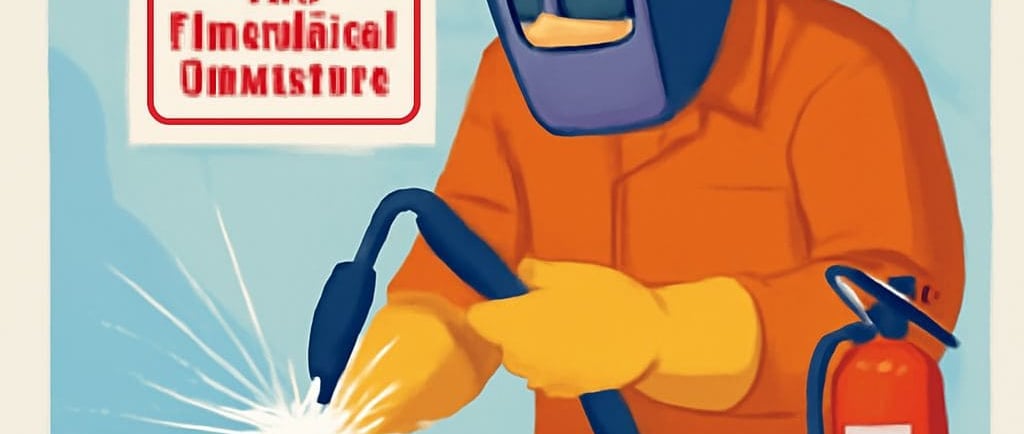Hot Work activity safety related topics from CSM and Osha
Hot Work from the most famous book in the field of health and safety which is CSM (construction safety manual) and this book is based on the basis of osha. So the activity of "Hot Work" is a critical and specific type of hazardous activity, the information is compiled from various relevant sections (like Fire, Confined Space, Compressed Gas Cylinders, and power Tools).
HOMESAFETY FIELD FOR LEARNING EARNINGSAFETY FIRST
HSE Officer
9/12/20254 min read


This topic is about Hot Work from the most famous book in the field of health and safety which is CSM (construction safety manual) and this book is based on the basis of osha. So the activity of "Hot Work" is a critical and specific type of hazardous activity, the information is compiled from various relevant sections (like Fire, Confined Space, Compressed Gas Cylinders, and power Tools).
1. Definition
Any activity which involves in the open flames, produces sparks, or generates heat is called hot work. This includes:
Welding (Oxy-fuel and electric arc)
Grinding
Cutting
Brazing
Soldering
Thawing pipes
Using powder-actuated tools
2. Key Hazard: Fire
Hot work is a primary cause of fire.
Fire Triangle: Fire is a chain reaction of oxygen, fuel, and heat. Hot work provides the heat and can easily ignite nearby any type of combustible materials.
Lower Explosive Limit (LEL): The minimum concentration of flammable gas or vapor in the air that can ignite. Lower from this concentration, no ignition possible.
Upper Explosive Limit (UEL): The maximum concentration of the flammable gas or vapor in air that can ignite. More than this concentration, no ignition possible.
Flashpoint: The minimum temperature at which a liquid gives off enough vapor to ignite.
For example:
Gasoline has a very low flashpoint (around -45°F or -43°C), so it can catch fire easily at normal temperatures.
Motor oil has a high flashpoint (over 400°F or 200°C), so it’s much harder to ignite.
3. Permit to Work (GI 2.100)
A Hot Work Permit (SA form no 9873.2) is a mandatory written authorization and agreement( between issuer and receiver) required before performing any hot work activity.
It is part of the Permit to Work system that evaluates hazards and specifies precautions for a specific activity in a specific location.
4. Fire Precautions
Fire Watch: A trained Fire Watch must be deployed with a competency card during hot work operations. His role is to monitor for fires and have the means to extinguish them.
Fire Prevention and protection
Prevention: action before catching fire. (separates the combustible material from near fire activity).
Protection: action after catching fire. ( Using a fire extinguisher to protect the worker, equipment, and environment).
Fire Extinguishers: Must be available 10 to 15 feet from the hot work area.
Wind Direction: Always approach a fire from the crosswind or upwind direction. For the purpose of knowing the wind direction, look everywhere for a windsock.
Remove Combustibles: Flammable and combustible materials must be removed from the work area.
Good Housekeeping: Good housekeeping can prevent the fire, and no fuel will be available to spread it, or even catch it..
5. Continuous Gas Monitoring in Confined Spaces
When hot work is performed, especially in a confined space, continuous gas monitoring is mandatory.
Gases Monitored:
According to Osha and CSM the below gases must be in the limited range…
Oxygen (O₂): Must be between 19.5% and 23.5%. Below is an oxygen deficiency (cause suffocation), above is an oxygen-enriched (highly flammable) atmosphere.
Lower Explosive Limit (LEL): Monitored to ensure the atmosphere is not flammable. The reading in the gas tester must be zero LEL.
Carbon Monoxide (CO): Must be less than 35 PPM (Parts par million). A toxic, odorless gas produced by incomplete combustion.
More than 35ppm must use SCBA. (Self-Contained Breathing Apparatus). This situation is called STEL (Short-Term Exposure Limit.)
More than 100ppm work is not allowed. This situation is called EDLH (immediately dangerous to life and health.)
Hydrogen Sulfide (H₂S): A toxic gas; a normal working environment (PEL) is less than10 PPM.
A CO detector shall continuously monitor the atmosphere when hot work is in progress inside a confined space.
6. Compressed Gas Cylinder Safety (for Oxy-fuel work)
Flashback Arrestor: A mandatory safety device used on oxygen and acetylene torches to stop the flame from traveling back into the equipment or supply line, preventing explosion, and for the safety of the operator.
Safe Storage Distance: Oxygen and acetylene cylinders must be stored 6.1 meters (20 ft) apart.
or separated by a 1/2-hour fire-rated barrier at least 1.5m (5ft) high.
Leak Check: Check hoses for leaks using soapy water which generates bubbles to show the leaks.
General Cylinder Rules:
Cylinders must be secured upright.
Keep valves and connections free of oil and grease (especially oxygen).
Protective caps must be on when not in use.
Never allow cylinders to come into contact with electrical circuits. Keep separate.
Any type of cylinder, especially Compressed gas cylinders are NOT allowed inside a confined space.
7. Tools and Equipment Safety
Angle Grinder:
Dead Man Switch: A mandatory switch that deactivates the tool if the operator loses control.
Trigger lock switches are not allowed.
RPM Rating: The grinder wheel's RPM must be greater than or equal to the grinder's RPM to prevent the disk from exploding.
Safety Guard: Manufacturer Guard never be removed.
Right Disk for the right Job: A cutting disk shall not be used for grinding or other activity.
Powder-Actuated Tools: Are considered hot work and require a permit. (it is a small tool like gun, using shoot nails)
8. Personal Protective Equipment (PPE)
There are two types of PPE’s, special PPE used for special activity. And mandatory PPE (helmet, glasses, shoes) which is mandatory for any type of site, for everyone.
Special PPE is required for hot work, which is more than the standard mandatory PPE.
Welding: Welding hood / helmet.
FR Clothing: Flame-Resistant Clothing (FRC) is required where there are fire hazards, or fire activity.
Grinding: Face shield, safety glasses, apron, leather gloves, and respiratory protection as needed.
General: Hearing protection is often required due to high noise levels.
According to OSHA, earplugs must provide (hearing protection) when noise levels exceed 85 DB. (decibels)
9. Emergency Preparedness
Everyone knows the Emergency Response Plan (ERP).
Know the location of emergency equipment like fire alarms, extinguishers, and first aid kits.
Know the evacuation routes (exit) and assembly area.
Everyone knows how to report an emergency.
10. Key Roles & Competencies
Permit Authorizer: Issues the hot work permit.
Gas Tester: Authorized Gas Tester performs atmospheric checks before and during activity, time to time.
Fire Watch: Must be authorized, trained and dedicated to monitoring fire.
Operator: Must be trained and certified to use the specific equipment (welder, grinder, etc).
Best blog posts
full excavation revision for HSEO's
The Hidden Stories of Workers: A Journey of Earning, Learning, and Living Between Lines
The Soil Compactor and the Secret to Success: Lessons from the Ground Up
Summary of the Construction Safety Manual (CSM) – 5th Edition
Unlocking Safety Excellence: A Look Inside the Saudi Aramco Construction Safety Manual CSM (5th Edition)
Mastering Construction Safety: Why the CSM is Your Ultimate Jobsite Guardian
Smart Planning for Earning and Learning: A Path to Growth and Stability
Why the Saudi Aramco Construction Safety Manual Is One of the Most Important Books in the Industry
#HotWorkSafety #WeldingSafety #FirePrevention #WorkplaceSafety #SafetyFirst #PermitToWork #ConfinedSpaceSafety #PPE #OccupationalSafety #IndustrialSafety #HazardControl #FireWatch #SafetyTraining #SafetyAwareness #ConstructionSafety

